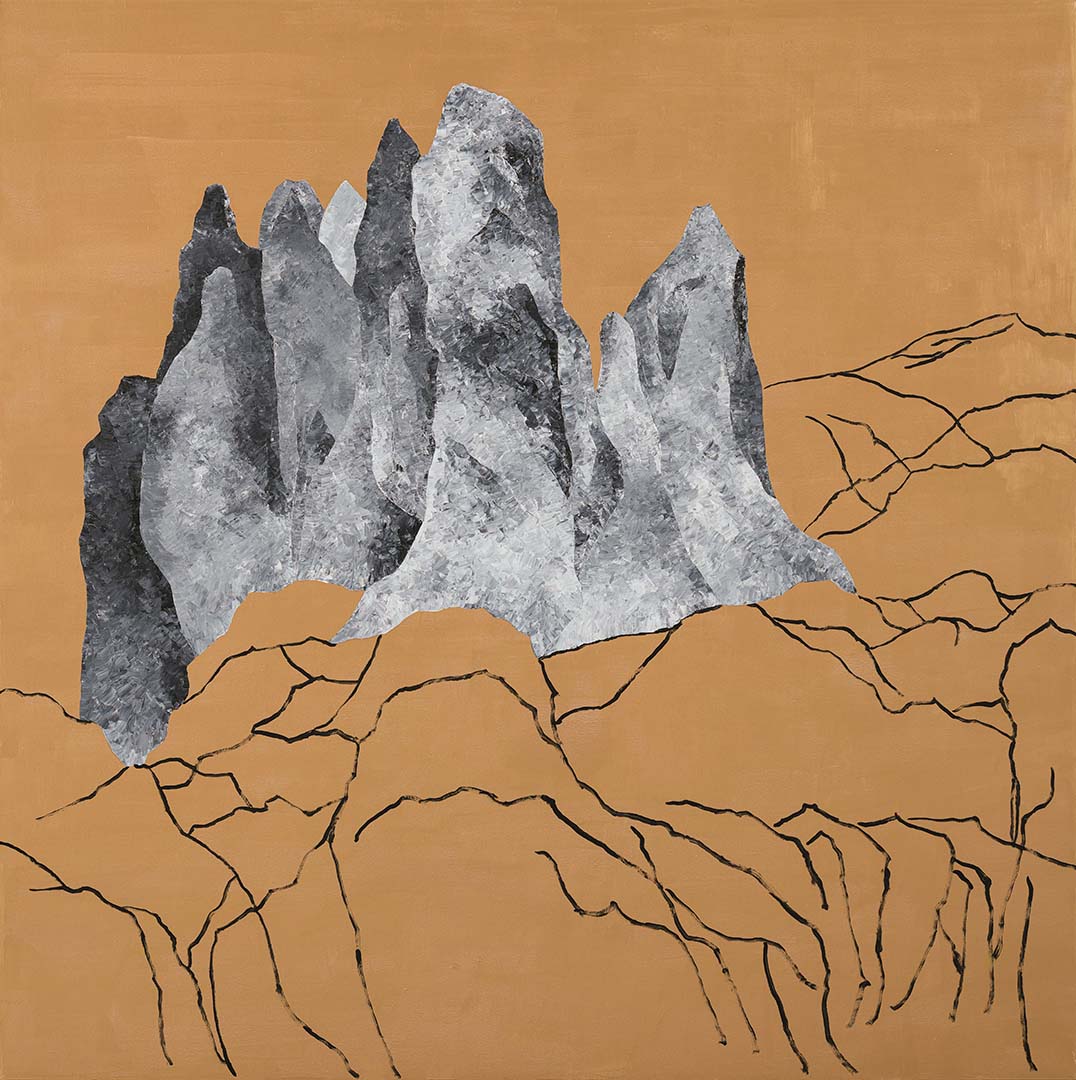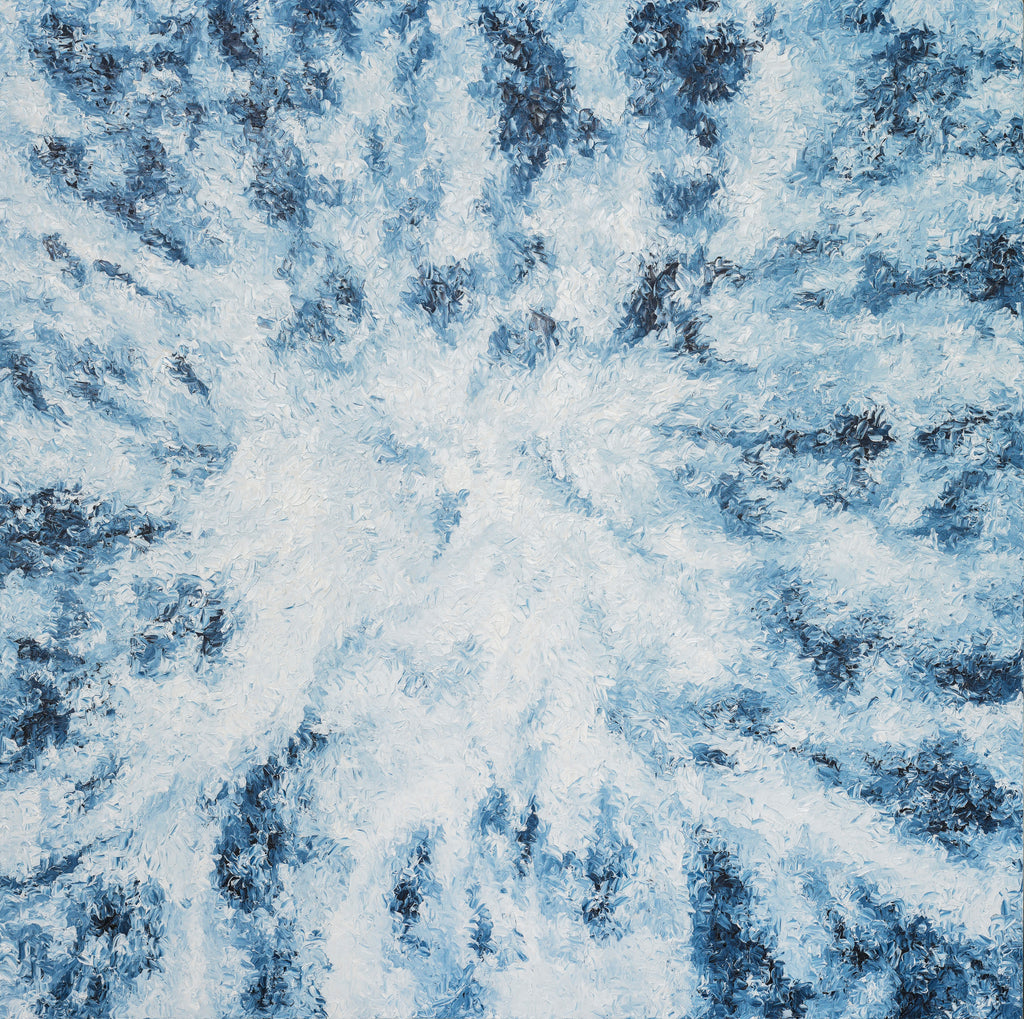ARTICLES
The Innovative Journey of Tianjin Ren: An Exploration of the "The Traces of Driving Rapids"
2024.08.29
INTERVIEW

Tianjin Ren at Whitestone Gallery Beijing
Whitestone Gallery Beijing recently featured Tianjin Ren's exhibition, The Traces of Driving Rapids. In this interview, Ren delves into his creative process and the allure of his works, maintaining his characteristic spirit of innovation.
The Simplified Chinese quoted directly from "Absolute" magazine; translations by Whitestone Gallery.

Tianjin Ren's Solo Exhibition "The Traces of Driving Rapids" at Whitestone Gallery Beijing
"Emergence" is the process by which quantitative changes trigger qualitative transformations, a dialogue between the new and the old. It exists in nature, among living organisms, and throughout the cosmos. It is the birthplace of creativity and possibility. While humans cannot control the emergence beyond their essence, they can occasionally tune into the frequency of their inner emergence. By engaging in deep learning, we can engage in a dance with our ever-evolving selves at the edge of chaos, inching closer to the possibility of rewriting the sequence of the future.
Tianjin Ren's artistic creations are akin to a dialogue with the flow of his inner emergence, a practice in the exchange of energy with his subjects. Through his unique artistic language, he explores paths to reconstruct his modes of existence and spiritual core.
The Traces of Driving Rapids: A Flow of Creativity
Over the past six years, Tianjin Ren has engaged in highly experimental and prolific creations, utilizing a diverse array of painting tools to produce a series of works rich in texture and distinct in style. The Whitestone Gallery exhibition, “The Traces of Driving Rapids,” features Ren's "Script" series, where each stroke is marked by individuality and variation. The "Slalom" series represents a transitional phase in which the artist moved from abstract coding to figurative shaping using a palette knife.

Tianjin Ren, Script 'E', 2019, 80.0×120.0cm, Acrylic on canvas
Absolute Magazine: Could you discuss how your upbringing influenced your artistic awakening? How did you embark on the path of art, and who were the key figures or moments that significantly impacted your artistic career?
Tianjin Ren: Around the age of twenty, I met a scholar in Shanghai named Hong Fimo, who was also a writer and calligrapher. His influence led me to interact with artists active in the 1980s. As the 1990s progressed, I frequently traveled between East and West.
During my further studies at the China Academy of Art, my doctoral advisor, Professor Wang Dongling, had a profound impact on me. He is an artist of great innovation whose works are celebrated on the international stage. Later, I completed postdoctoral research at the Haas School of Business, University of California, Berkeley. I collaborated with Professor Henry Chesbrough to apply the theory of "Open Innovation" to the feasibility of artistic innovation.

Tianjin Ren's Solo Exhibition "The Traces of Driving Rapids" at Whitestone Gallery Beijing
Absolute Magazine: How has this interdisciplinary study shaped your unique artistic perspective and creative philosophy?
Tianjin Ren: This has been a natural progression, rather than something I deliberately pursued. I went to the United States in the early 1990s, where I was exposed to a vast array of Western art. Most of my works reflect a fusion of Eastern and Western elements, but the core remains the traditional Chinese art of line drawing. This fusion is evident in the current exhibition at Whitestone Gallery "The Traces of Driving Rapids".
You mentioned "interdisciplinary," but in reality, I haven't undertaken a true crossover or interdisciplinary exploration. My artistic practice has always centered around "writing," though the forms have evolved. During the creative process, I experiment with different media and materials to replace traditional ink and paper. While some works might evoke a sense of traditional Chinese painting, they are no longer confined to that tradition.

What Changes and What Remains?
Tianjin Ren's multifaceted identity has shaped his ability to navigate abundant social resources while also delving deeply into introspection. His profound reflections on calligraphy within both Eastern and Western cultural contexts are evident in his creations.
He approaches calligraphy with a rigorous aesthetic—understanding the holistic appreciation of text, composition, brushwork, and ink nuances within the Chinese cultural sphere, while also recognizing the limitations of Western viewers, who tend to focus more on composition and brushstroke dynamics. Through this understanding, he realizes that Eastern calligraphers can achieve a modern transformation from within by drawing inspiration from Western appreciation methods.

Tianjin Ren's Solo Exhibition "The Traces of Driving Rapids" at Whitestone Gallery Beijing
Absolute Magazine: How do you perceive the differences in audience and attention your work receives domestically and abroad?
Tianjin Ren: I believe these differences stem from cultural backgrounds. Western audiences often see "the East within the West," while Eastern audiences see "the West within the East."
Absolute Magazine: How do you find a balance between tradition and modernity in your work?
Tianjin Ren: Moving from tradition to innovation is a process of transforming traditional elements into modern forms. Jay Xu, the director of the Asian Art Museum in San Francisco, once mentioned during a lecture at Harvard University that ancient works were contemporary in their time. What we now consider traditional was once contemporary. This suggests that the distinction between tradition and modernity is merely temporal, with no absolute boundaries.
With this perspective, we can consider how to use modern media or artistic language to express past contemporary concepts, adapting them to modern contexts and creating new forms of art.
Transitioning from tradition to innovation is not just a temporal leap but a thoughtful process that requires the careful use of modern media and artistic language, while also considering the sustainability and vitality of the work.

Tianjin Ren, The Dream of Cloud:Cadmium Yellow, 2024, 25.4×80.0cm, Acrylic on canvas
Absolute Magazine: In modern society, artists' innovations are often influenced by commerce. How do you understand the relationship between these two forces?
Tianjin Ren: Previously, I gave a lecture titled Art and Commerce at the Ed Design School, where I discussed:
"Commerce and art have never existed independently. Art needs to be sold and promoted, while commerce advances art's sustainability. The two complement and support each other. The artistic quality of commerce helps it stand out in the competitive market, while the commercial aspect of art provides broader exposure and material support for further development."
On one hand, art provides commerce with unique creative resources and aesthetic value, enriching commercial activities. On the other hand, commerce provides art with the necessary economic foundation and market platform, ensuring the continuity and impact of artistic creation. This relationship extends beyond the commercialization of artworks, deeply influencing artistic concepts, the art market, and even the cultural ecosystem.

Tianjin Ren's Solo Exhibition "The Traces of Driving Rapids" at Whitestone Gallery Beijing
When We Uphold Tradition, What Are We Upholding?
The Whitestone Gallery exhibition "The Traces of Driving Rapids" also features Ren's series "Les Jardins de Giverny", "Silhouette", "A Space Odyssey", and "The Dream of Cloud". Viewers are invited to discover hidden pictographs within the spaces constructed by brushstrokes, feel the spiritual energy of landscapes, and experience the exchange of energy between people and these works. The exhibition also showcases Ren's most impactful sculptures, including the "Taihu Rock" and "Populus Euphratica" series, which blend ancient traditions with contemporary vitality, prompting reflection on life and truth.

Tianjin Ren, Slalom: Rapids 1, 2024, 200.0×200.0cm, Acrylic on canvas
Absolute Magazine: What works are featured in your current solo exhibition at Whitestone Gallery? For example, what inspired the creation of “Taihu Rock-East Wind”? What story or meaning does it convey, and how is the concept of "East Wind" reflected in the work?
Tianjin Ren: "East Wind" refers to the Chinese proverb "Everything is ready, except for the East Wind." Calligraphy is an essential component of East Asian culture, yet it is one of the most challenging aspects for Western audiences to appreciate. Therefore, I utilized the natural texture of “Taihu Rock” to form the cursive script for "East Wind."
“Taihu Rock” are rare and exquisite limestone formations eroded over time by natural forces. They are one of the four famous ancient ornamental stones in China, named after the Taihu Lake region where they are widely found. Since the Tang Dynasty, these naturally sculpted, uniquely shaped stones have been beloved by Chinese literati, often placed in gardens as symbols of nature's beauty and the medium for expressing one's feelings. In the West, these poetic stones are aptly named "scholar’s rocks," conveying their unique charm and profound significance in Chinese culture.
Here, I combined these two elements, aiming to deconstruct the traditional content of calligraphy in its original two-dimensional space and then reconstruct it to form a new artistic language.

Tianjin Ren, Taihu Rock-East Wind, 2024, 64.6 x 48.3 x 100.0cm, Stainless steel 316
Absolute Magazine: What creative philosophy do you hope to express through this exhibition, and how should we understand the "The Traces of Driving Rapids"?
Tianjin Ren: In Chinese "涌" represents a positive transformation. Specifically, emergence is the process where the accumulation of quantitative changes leads to qualitative shifts, reflecting the interaction and resonance between new and old elements. This phenomenon is pervasive in nature, life, and the vast universe, serving as the source of creativity and possibility. While humans cannot control the emergence of things beyond their essence, they can occasionally capture the frequency of new emergence related to themselves.
Therefore, by engaging in deep learning and dialogue with the ever-changing self on the edge of chaos, individuals can approach the possibility of rewriting the temporal sequence of development. In essence, this is a deep process, centered on continuous dialogue between new and old elements or between individuals and themselves, ultimately leading to an experience of flow and emergence.

Tianjin Ren, Crossing: Fisherman in the Snowy Stream, 2023, 80.0 x 120.0cm, Acrylic on canvas
The Simplified Chinese quoted directly from "Absolute" magazine; translations by Whitestone Gallery.
View and purchase Tianjin Ren's artwork online by clicking the link below.